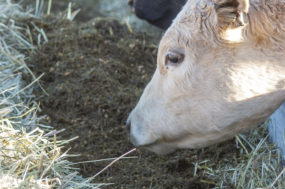“Somewhere between giddily goofy and gloomy, you will find a happy medium,” I pontificated while attempting to quell a near riot in the living room.
“Is that the same as a drunk soothsayer?” Quipped one of the teenagers I had been trying to move from “riot” to “sane and sensible.”
“What?”
“A happy medium.”
Whichever one it was, I remember trying to swat him – a move he anticipated and dove for cover before he had finished mouthing off.
The keynote speaker at the lunch break of the Washington Hay Expo last month spoke about depression, stress and suicide among not just hay growers but all of agriculture.
The summer I turned 10, Dad sold the farm, and we moved to town, the proud new owners of a small motel. One of my chores was to load and keep stocked a pop machine. Glass bottles of Royal Crown cola, Upper Ten soda and various Nehi-brand flavors of what Dad called “soda water.”
The bottles hung by the neck in rows with the cap visible. A purchaser would part with a shiny dime, which would unlock an exit gate that allowed only one bottle to be pulled up and out of the machine. I remember Mom was livid one day. Someone had used a bottle opener and popped off the caps on a handful of bottles in the pop machine, and then emptied them with the help of a drinking straw.
Every week or two, a truck would show up and credit us for the empty bottles and leave us a fresh inventory of full bottles of pop. It was a Ford “C-model” truck, 1953 through 1956 vintage and, since we moved there in 1956, it was a relatively new truck. Even then I was a truck junkie, so I knew it was the C-600 model and I thought that it, with its high-rounded nose of the cab-over-engine style, was super-neat. The driver was a robust fellow with wavy, almost blond hair. He always seemed friendly, and I admired his ability to sling the cases of bottles with accuracy and ease.
Then, one day, the truck was a few days late and showed up with a different driver. The new guy seemed all business, and I missed the friendly face that used to drive that truck. I asked Dad what happened to the old driver. Dad got quiet, and I could tell he was uncomfortable. He made sure my younger siblings were nowhere near; then he said, “He shot himself.” I was stunned. I asked why, and Dad said he had no idea. I could tell that Dad wasn’t comfortable, so I never brought the subject up again.
Now jumping from 1959 to 2020 – our speaker at the hay conference talked about some incorrect myths about suicide. She brought up a possible scenario where the man in charge of what had been the family farm for generations was to the point of foreclosure due to market conditions, weather and some just good, old-fashioned bad luck. A big, strong robust fourth-generation farmer on that land now in his early 60s was facing the unknown, as he was about to lose it all.
She said if he’d had a heart attack and was incapacitated for several months, his neighbors in the community would have rallied and made sure his crops were harvested on schedule, as well as whatever else was needed to keep the place intact for their neighbor and friend. A financial upset, however, could be hidden from his neighbors and, in fact, could have been hidden from his own family.
If he had a piece of machinery he was working on in his shop fall and break his leg, and pin him under it, he’d call a neighbor to come with his big loader and lift the machine up to free him. He’d call his wife to get an ambulance coming. He’d call family or helpers to take over while he went for medical care. But in the midst of a financial, marital or emotional crisis, he could be paralyzed from calling for help. He may not even know who to call. He may not think there was any use calling, feeling that no one would understand his despair, possibly even laugh at him. How could such a big, strong, robust fellow as he was possibly be unable to cope?
Our speaker listed as false the myth that to ask someone whose demeanor has changed if they have thought about suicide would cause them to take that action. Most, she said, would be relieved that someone noticed their distress.
Another myth is: There generally were no signs that someone was in distress. The majority, she went on, will exhibit more than a few signs of being in trouble emotionally.
We were challenged to pay attention to those around us, those we know fairly well and, when we see a change in personality, a change in behavior, to speak up. A simple “Hey, Bubba, you ain’t been eatin’ donuts with us at the store every morning. Is your world OK?” could be the opening someone needs to start a conversation that leads to help. Be aware of the resources in your area. Be able to tell someone to, or better yet help someone, make that call.
Being overwhelmed emotionally over whatever situation we think we are in is as much a medical emergency as a heart attack or stroke or ruptured appendix.
And last, a sane person would never harm himself or herself. That said, in the unfortunate event that a family or community member leaves this world by their own hand, please show the surviving family members the same respectful condolences you would had they lost someone to an accident or cancer.
We would never expect constant smiles and laughter from ourselves or others. Hopefully, we can notice those around us, and when someone moves toward gloom and despair be able to at least say something, if not to the person themselves, then to someone possibly closer to them, that they need a lifeline. Agriculture is family. A big, diverse yet caring family. Do take note of those who would be at your doorstep in a moment if they knew it was you in distress.
If you or anyone you know is struggling with suicidal thoughts, please reach out to the National Suicide Prevention Lifeline at (800) 273-8255. It is a national network of local crisis centers that provides free and confidential emotional support to people in suicidal crisis or emotional distress 24 hours a day, seven days a week.











